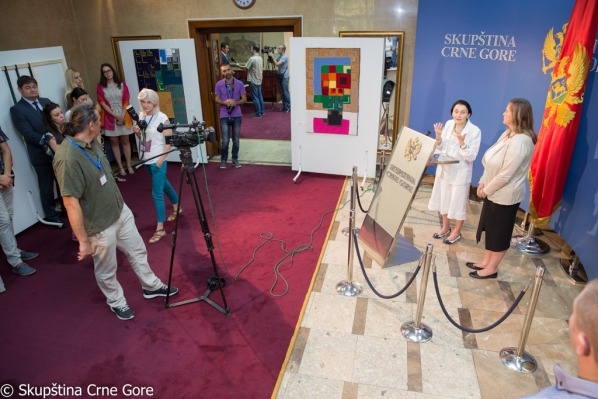The exhibition of tapestries titled “The thread is a trail”, whose authoress is MP Ms Jelisava Kalezić, was opened in the Hall of the Parliament of Montenegro. The exhibition is organised with the support of the Gender Equality Committee, on the occasion of the 70th anniversary since women in Montenegro gained the right to vote, 75 years since women participated for the first time in the election of local authorities in Berane and 75th anniversary of the 13th July Uprising. The exhibition presented tapestries made in the period 1972-2016: Triptych –Spring, Summer, Autumn; The Missing Diptych – Autumn in the Lim River Valley; Winter in the Tara River Canyon; A Prayer to St. Parascheva, Paul Klee And Me; October by the Rivers Bistrica and Lim; By the Window at 5000m, Thinking about Kandinsky; After one Hundred Years: The Blossoming of Malevich’s Black Square; Summer in the Vranes Valley: A Clear Night and a Sunny Day; Flowers by the Window, for Vincent.
Ms Nada Drobnjak, Chairperson of the Gender Equality Committee, opened the exhibition, attended by MPs, representatives of international organisations, civil sector, state authorities, citizens and parliamentary staff.
By opening the exhibition, Ms Nada Drobnjak said that it might look unusual at the first glance that the Gender Equality Committee decided to mark big jubilees by opening the exhibition of tapestries, but that the essential message of this act was that women as much as men had participated in creating society, carrying with themselves both tangible and intangible cultural treasure of Montenegro.
Speaking on presented work of arts, she said “We have in front of us a Jelisava’s story of four seasons, reminder that we are all at a loss during instable times, which includes her work also, because “Diptych – Autumn in the Lim River Valley” was lost in Sarajevo’s war sufferings. There is also St. Parascheva, considered to be a protector of women, and the authoress and Mr Paul Klee are praying to her. Mr Klee said that art does not imitate the visible world - she enables its existence. “October by the Rivers Bistrica and Lim” reminds of verses of homeland of poet Mr Risto Ratković “My homeland Lim, there are no waves that gurgle so dearly like yours”. By looking at tapestry “By the Window at 5000m, Thinking about Kandinsky” we cannot not to remember his opinion that every colour has three important movements - from observer, towards the observer and within itself. Mr Malevich painted Black Square in 1915 at white background and called it “Frame-less icon of my time”, which, it can be said, presented the creation of supremacism, which, in its platform, emphasised the necessity of “economic reforms”. After 100 years at Jelisava’s tapestry, this square is blossoming, but still remains in its economic form and, I am convinced, continues “Frame-less icon of Jelisava’s time”. “Summer in the Vranes Valley: A Clear Night and a Sunny Day” is a return to homeland but also to positive emotions. Flowers were one of inspirations of painter Mr Vincent van Gogh, and it is believed that works of art with characteristic flowers were made in the periods of the artist’s optimistic state. He used to say that “"real painters do not paint things as they are... they paint them as they themselves feel them to be”, and Jelisava’s spirit felt that it should present flowers to Vinset. By her thread Jelisava has left not only her own trail, but also a trail of women cultural heritage, and we are grateful that her thread, as Ariadne, help us to follow our own trail and exit the labyrinth.
Authoress of the exhibition “The thread is a trail” Ms Jelisava Kalezić thanked to everyone who participated in the organisation of this exhibition, which marked important dates from the history of Montenegrin nation, stressing that the work on tapestries was her spontaneous asylum in cultural heritage of her women ancestors. Also, she expressed conviction that by this exhibition she might encourage different relation and greater respect of homemade works of women in Montenegro, because this craft is disappearing, and this is a precious part of our tangible and intangible cultural culture.









